ABANYALA BA KAKAMEGA: Abanyala Music, Dances and Clothing
Abanyala ba Kakamega have songs and dances during most of their cultural activities. The singing and dancing comprise of key elements: the dancing arena (omuse), authentic songs melodies (emienya), the singers (ab'embi), the authentic dance styles (oukhino), the authentic costumes and decor (emiefwalo) and authentic instrumentation (amakhana).
Abanyala dances are usually fast paced dances. Their main indigenous dance is called chilumbe.
A] SONGS AND DANCE IN CULTURAL SETTING
Most cultural activities have an accompanying song. Abanyala sing during any of the following situations:
a) During the following ceremonial rites, songs and dance were performed:
- Funeral (emienya kya esibera) sang during and, after funeral occassions.
- Marriage (emienya kya emitialo) sang before, during and imediately after a marriage ceremony.
- Child naming (emienya kya okhukulikha),
- After-baby-birth celebrations (emienya kya okhutucha)
- Circumcision (emienya kya okhuminya) sang before, during and immediately after circumcision.
- Mudding of circumcision candidate (omwenya kwa okhwikulira) usually one song that has two parts sang while moving with the circumcision candidate back home from the river to the home to face the knife.
- Tatooing (emienya kya esisalako) sang by the tatooing candidates as they carry sorghum or millet to those who do the tatoos.
- Dowry payment (emienya kya esiserero) sang by those going to pay dowry or those taking away the dowry. For example, 'Nalulingo yikhoya yikole.'
- Twin ceremony songs (emienya kya ebasa) sang to mark the twin ceremony. Usually vulgar in content and performance.
- Evening narrating (emienya kya engano),
- Praise speeches (emienya kya esilosio),
- Coronation of leaders and prayer songs
- Children games (emienya kya nalukhasikhasi),
- Adult games (emienya kya okhukobia ebise),
- Mock fights (emienya kya okhusuliana),
- Animal fighting (emienya kya amakhu),
- Turg of war and wrestling (emienya kya amawi),
- Beer drinking (emienya kya enjengekho),
- Welcoming new year and denouncing bad spirits (emienya kya nabaaba),
- Mock wars (emienya kya eye)
- Songs for dramatizations of functions such as mock circumcision upon the death of a circumcisor (emienya kya emitiebano) etc
c) During the following religious activities, songs were sang
- Worshiping at shrines (emienya kya esabo)
- Songs for blessing (emienya kya olubito),
- Exorcising evil spirits (emienya kya emisambwa),
- Rain dance (emienya kya okhukimba)
- Songs and dance in this category could move to a level where they are done under possession of spirit. Such took the form of solo chants. For example, those possessed by the evil spirit of nightrunning were observed to perform some unique night running chant: Ndi omulosi Namakangala.
d) During some work activities we had work songs
- These are collectively called work songs (emienya kya emirimo). They are for work activities that takes long to accomplish: hunting, tilling land, rowing a boat, cutting grass for thatching, grinding flour on stones, threshing millet, harvesting millet, mudding houses, collecting firewood, pottery working, curving, working with mortar and pestle, shaking milk in guards to make cheese, winnowing, weeding, basketry work, blacksmithing, fishing, hearding, harvesting white ants, baby sitting etc For example, the blacksmithing song "Mukuba muhambe."
B] ABANYALA AUTHENTIC MUSICAL INSTRUMENTS
The musical instruments, that accompanied folk songs and dances, among the Abanyala were collectively called amakhana. Some could be played as solos while others as an ensemble. There were specific ensemble ensemble families dictated by the cultural activity and dance type.
Among the Abanyala ba Kakamega, those playing instruments were, in most cases, part of the singers and dancers. Due to being paid before playing, they picked a name of the medium of payment then: abapeni.
The instruments are played by blowing air in amakhana ka emiuya, percussion in amakhana makhong'onde, shakers in amakhana masakasa, string in amakhana matindula or amakhana masiisa.
The instrumentation had to be right in terms of: positioning, posture, rhythmic motif, play technic, size, material and timbre combination pertinent to each instrument. Just the way Abanyala language is unique, the above aspects of instrumentation had to ensure the rhythm talk the unique instrumental language of the Abanyala. The following are key instruments:
- Amatinda or omuranda- Rarely used nowadays due to lack of skilled players among Abanyala. It was played by three or more people to produce twelve notes. One person played the two high notes while the other two played the remaining ten all tuned to a pentatonic scale. Originally the resonator was made of parallel banana stem on which bars were placed or a hole dug on the ground. Almost similar to amadinda of the Baganda in structure and form. The Abanyala plays it and dances to it the same way Abaganda do. Its dance style is called okhunyabala or okhutindukha.

Amatinda or omuranda - Amarende- these are percussive instruments made by putting dry seeds in a hollow shell from the fruits of encopa sinosa tree. They are tied on the leg of dancers during celebratory dances such as the marriage dance of emitialo.

Amarende - Amayi- hand clappers. They formed part of the musical enhancement at some point within the singing and dance. Commonly used for praise songs. At times, special clappers were made from wood.

Amayi - Efurimbi- whiste. They were made from reeds or clay soil. They are played during circumcision dances. One whistle produced two notes at ago due to holes on either side. In fact, during circumcision ceremony, the last whistle was done by the circumcisor to signal the end of the operation.

Efurimbi - Ekhombi- a type of single horned trumpet that was slightly shorter. Its sound is heard in the recorded wrestling song "Aha Chabuyabuya ha!"
- Embengele- two sticks hit against some horizontally placed wooden bar called esiiye. Esiye had resonator space. The tray was tied around the neck to hang in front at the waist. Below is esiye with holes into which a string is attached for it to hang such that it can then be hit with two sticks.

Esiye for embengele - Embindo- stamping. Done while moving forward and backward. Common with the dance called okhuracha. At times it is accampanied with the rhythmic knocking of the walking sticks on ground.
- Emianjo- a pair of short sticks held in hands and hit against each other to produce sound during dancing.

Emianjo - Emoyi- string instrument made from calabash, bow and string. It is played using a bow. It is same to entono from the Kuria in structure. The instrument was majorly used by traditional medicinemen to expell evil spirits. This made it to almost become rare as Christianity spread out among the Abanyala.

Emoyi - Endeke- jingles tied around ankles and usually given to a litungu or eshilili player or the soloist. Abanyala had three types of endeke: ebichenje that were slightly bigger leg jingles (female) tied on the thigh area, namunjiri that were smaller (male) leg jingles tied on the shin area and ebikhuli that were the smallest and tied on the arms or leg ankles. Ebikhuli were also put in hunting dogs and provided a great accampanment to the hunting chants.

Ebichenje - Endulienge- pan flute. These were a bundle of flutes-like wind instruments made from stem of the elephant grass or bamboo. They were made by sliting their sides of the reeds or making them the stopped flute type. They were skillfully blown across to give a melody. The reeds were of various length, width and sizes. They could range from five to ten depending on skills of the player.

Endulienge - Eng'oma ekhwana (twin-drums)- usually a drum set of two or four drums or six drums that tied around the waist and played by one person. They were hit by two sticks to produce a melody.
- Eng'oma efumbo- similar to musondo
- Eng'oma endoli- smaller endondoli.
- Eng'oma endondoli- a big double membrane drum thar gave rhythm to the drumming when hit by hands on both sides.
- Eng'oma engerabe- a long drum whose head is made from skin of monitor lizard. It was the original royal drum of Abanyala during the rule of chief Mukhamba. It has a small lower resonator part. It is held between the legs while playing with hands. Women never played engerabe because it looked indecent to have the phallic looking drum between their legs. Only one engarabe was allowed to be played at a time in the arena.

Engerabe - Eng'oma ya Sookho (usekete)- It was originally the royal thunder drum used by the chief to call people to came for an urgent function. When chief Masiribayi staged a peaceful coup against chief Nasookho- by bringing rain after prolonged drought, the drum was picked as the royal drum to replace engerabe. The drum found its way into the Abanyala songs and dances.

Sookho (usekete) - Enyengo- guards with seeds inside or stringed shells on surface to act as shakers. During music and dance, two shakers were never used by one person at same time because two shakers had a functional role in the culture for they were used by traditional doctors to exorcise evil spirits.
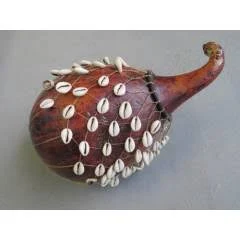
Enyengo - Enyimba- common during circumcision dances. Usually played by men to be inciated. Those who had gone through the ritual were not allowed to play. Usually played in pairs unless in one of the last song before the circumcision event. It has an accompanying metal ring put around the wrist called esitiri. When singing the last song of okhwikulira called esioyaye, only one jingle is played.

Boys playing enyimba - Enyungu ya olubende- pot, usually with a long mouth, hit with cooking-stick-like stick covered with soft skin. Soil or sand is put in it during turning.

Esongo ya olubende - Esikuti (Omutindi)- these were usually three drums that operated as a family. The original name was omutindi before the whiteman who praised it by saying 'it is good' hence the term esikuti for "is good." The drum set had the father drum (omutindi musacha), mother drum (omutindi mukhasi) and child drum (esitindi). The main dance that made use of esikuti were the wrestling dance called amawi. Each of the three was played by a different persom. Metal ring or esikhuli was part of the ensemble.

Esikuti - Etungu- harp. It originally had seven strings. The etungu was tuned d r m f s l d'. However, there are reported cases of litungu with more strings to relate with keys on the piano. The late Willington Wambusi wa Musungu, a legendary Abanyala singer, increased the number to ten strings to help him change melodies with ease. It was taboo for females to play etungu or to play two of them within the same arena unless playing them by alternating.

Etungu - Esitiri (engong'i)- round metal ring held by left hand (esitiri) hit with another metal gong (engong'i) held by the right hand. Left handed were not allowed to play the metal ring since it was considered as 'leading the arena.'
- Esikhorowe- hand whisle. Made by bringing palms together to form a resonator as air is blown. Lifting the fingers skillfully lead to production of a melody. Females were discouraged from using it. Common for war, mock fight and animal fight dances.

Esikhorowe - Esikhutu- double bell. It was like a cow bell but without the inner gong. It is hit with a stick to produce a melody.

Esikhutu - Esinanda sichaanula- accordions introduced by world war veterans and perfected by friends of Bukusu man called Kilikinji in early 1940s. Not originally from Abanyala but it was common in local dances during the precolonial and early colonial era. Its dance was an imitation of foreign dance called the dance of olumbuchu (waltz)

Esinanda si chaanula - Esiriri- fiddle. It was played using a bow. Esiriri was considered to be the child to etungu for the two were played together.

Esiriri - Esiriri si khwaana- double string fiddle. One sting was manipulated to give the melody while the other gave the drone backup. It was greatly associated with exorcising spirits hence discarded during the emergence of Christianity.

Esuriri si khwana - Esisengeli (Esipeke)- shakers made by putting circular iron ring metals (amasengeli) on a string or wire then puting them on a stick. The metalic cuttings were replaced with metalic bottle tops from soda bottles hence the name esipeke (bottle top)
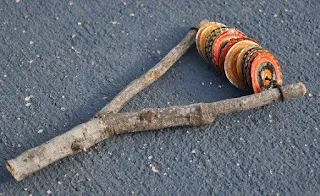
Esipekee - Eswichi- mouth whistle made by insering fingers in the mouth. Used at the peak of excitment in a song by men as women ullulated. Men are not supposed to give an ullulation- esikalakala.

Eswiichi - Ewumi- pipe. Usually a set two, four or six or or eight played with varying music pitches. Some had resonotor made from guard at its end. During circumcision ceremonies, they form good orchestra and are danced to during circumcision dances.

Ewumi - Nababa- cymbals made of metalic plates or hard guardsguard.
- Namakanda- thumb piano. It became extinct due to lack of skilled players. It was named namakanda for it resembled a giant frog called by same name.

Namakanda - Olwika- horn. Usually from rhino or waterbuck. Used at start of dance, change of melody and end. A long trumpet like horn was called esichiriba.

Olwika - Omulele- flute from reeds. They had four finger holes and a v-shapped slit across which air was blown. Flutes were played by two or more people to bring out enjoyable variety in the music. Smaller flutes were made from elephant reeds called esikata. Common with cattle hearders and love songs.

Omulele - Owukhana- Raft zither. Usually made from reeds and played by plucking.

Owukhana - Walubende- one or two string instrument made from a guard or wooden resonator and an arm. Before the mobile resonator was put into use, the detarched resonator was held by feet and the string, which was plucked to produce sound, held on the ground using a peg. At times, the mumber of strings were increased and fixed on a bowed handle. Played together with amatinda.
C] AUTHENTIC ABANYALA DANCE AND DANCE STYLES
- Chilumbe- Abanyala, due to having come into contact with many communities during migration, they acculturated, assimilated and syncretised various dance styles into one of their dances called Chilumbe dance. This was a social gathering dance that originated during the time of the leader of Abanyala called Mukhamba. Danced after hervest time when food was in plenty. Chilumbe was a celebratory dance which comprised of a mix of dance movements and styles done by moving in clockwise formations formation. The choice of specific dance body areas for movement focus during chilumbe dance depends on the rhythmic rendition of the instruments and specific dancer's preference. At times, one melody could allow a person to dance a style of his or her choice out of the following key dance movements that, together, formed chilumbe dance.
- Amabeka- this is basically shoulder dance. It is the key dance style in chilumbe. Though shoulders are the key areas of focus, there is a specific accepted style of stepping (okhuswala) on the ground and posture to be taken as one moves. The hands were left to communicate the words of the song through gestures such as bending palms down to look like a hoe, shaking them the way we shake weeds during weeding, blessing, imitating birds, swimming, pulling a rope etc. Shoulder dance in chilumbe has six main ways of shaking:
- Okhunikinia amabeka that involves vigorous shaking of the shoulders in continuous trembling manner;
- Okhukhupa amabeka (okhubekukha) that involved continuously flapping shoulders vertically- up and down. The tempo of flapping could vary from mild for the old to extreme fast for the youth.
- Okhukhupa wachacha (okhuchacha) that involved flapping shoulders horizontally- back and forth. The speed of flapping could be varied as per the tempo of the song.
- Okhutiembukha that involves swaying upper body- above the abdomen- up and down;
- Omuchenje that involves facing each other or pairing up side by side as you shake shoulders fast. The head is also involved in the movement;
- Okhwikhoola or okhwitwika which involves standing erect (like ekhooli- a giraffe) but shaking the shoulders vigorously as you make half turn at the waist.
- Lipala- This is basically a legs and arm dance. It is danced by moving feet back one at a time the way a chicken does when scratching the ground. At time, clapping, touching on forehead and moving ones hands as if fencing the air around the dancer.
- Okhwepotola- This was a decent waist dance that involved swinging the waist with an aim of spreading the sisal skirts or waist skin. The body movement is similar to the owalo dance of Abakhayo and ebodi dance of the Samia
- Okhuracha- This was another dance focusing on feet. It involves stamping on or both feet and kicking of legs back or forward while in motion.
- Okhwefwera or omukongo- kneeling or bending at waist and pushing the back up and down.
- Amawi dance (Dance of war or mock wrestle)- wrestling dance. It was usually accampanied by esikuti. Similar to esukuti dance of the Isukha but with some elements of esingorio dance moves.
- Okhutindukha or omunyabalo dance- it was a dance that accampanied omutinda instrumentation. It involved energetic waist shaking waist skins to the rhythm of omutinda, etungu, esiriri, eng'oma, walubende and Namakanda. The dance is similar to the Kiganda dance. Perfected by Abalanda, Abasia, Abakangala and Abamwaya.
- Dance of ebasa- twin dance. It was usualy performed at the rite to bring the twins out door the first time. It was obscene in perforformance hence danced in secrecy.
- Olumbuchu Dance- walts-like dance movements introduced by war veterans after coming back from first and second world war. It was danced to the accampanment of an accordion by the elderly. It is not an original Abanyala dance.
- Singorio Dance- basically done during rain dance, war dance, animal fighting, mock fight and wrestling dance. It was believed to have been borrowed from Masai due to assimilation of Masai clans of: Abasenya (Simbuchi), Abasonge (Songiek) and Abairifuma (Masiribayi). The dancers dash around fast, gracefully leap in air and stamp their feet as they shriek.
- Olubino dance- night runners dance.
- Omutibo- a mix of indigenous dance done by including some modern instrumentation and movements.
In an attempt to design modern costumes for use during performamnce of dances from Abanyala ba Kakamega, the following traditional clothing and costumes can be of great value.
a) Traditional indegenous clothing doubling as costumes.
Since most of the dances were done as part of the people's way of life, the people danced dressed in what they wore as clothing by the time the dance situation resented itself. The clothing became their costumes. The following are some of the attires that people dressed in and found themselves dancing in them.
- Ebukwaali- moaning attire collections used by men.
- Echabe- this was a royal robe for the leaders. It was made from a leopard skin that was constantly softened using special oil from milk. It was tied around the kneck to pass under the armpit of one arm. The leader could dance around dressed in it.
- Ekhalabanda- wooden shoe.
- Ekutu- whole skin softened and turned in a wrap cloth. It was folded at the corner to create an oval space for the hand and kneck. Ekutu that did not have the fur removed was called olware.

Women dressed in ekutu. - Ekutusi- Ceremonial hut for ordained leaders. The non ceremonial one did not have beads or shells and it was called esitai
- Ekutwa- royal hat used by leaders. It was lined with three things: woven palm leaves, blades from obuyeye grass and a layers of white cowrie shells.
- Enjabalia- a large skin that covered the whole body during sleeping time. Those got sleeping under it could stand and dance within it.
- Esiboywa- slightly longer upron that covered the front side from waist up to the knees for women. It was like a front half of a min-skirt. The behind half could be filled with fibre strings.
- Esichengwa- soft skin wrapped around the shoulders to cover the top chest and top back areas. Used by both men and women.
- Esiketera- loin cloth made from soft goat or calf skin. It was almost half the thigh length. It covered the gap left in front by the esiyula hence the name esiketera. If one did not have esiyula, it could be turned round to cover the nakedness based on the direction of the visitors.

Drawing showing esiketera at front. - Esikhonero (esikhonyi)- a wide strap of of soft leather that was attached to a string round the waist and passed between the thighs to be fixed on the string again on the other side of the body. Dressed by men and very useful during wrestling.
- Esimolo- groin cloth made from strong soft woven fibre strings of olusianyama plant fibre. It was the innermost attire for the women and men- similar to the G-string. Dressed under esiketera and esiyula.
- Esiyula- a slightly longer skin apron that covered the behind up to the knee bend for women. It was the eauivalent of a modern day skirt. The slit gap in front was filled with esiketera.

Esiyula - Esumbati- strong skin skirt used by warriors with front and back flaps.
- Oluleenga- strapping tied across the chest to put breasts in place.
b) Authentic dance costumes
Apart from dancing dressed in day to day clothing, there were pre-arranged dances where dancers and singers went having planned to dance. Such dances had specific costumes for the key dancers. The costumes enhanced the dance, highlighted key characters, marked the age, identified the dance type and distinguished the sexes. The following are the main costumes.
- Amaombolio- this were majorly climbers with leaves used to comouflage during twin dance and circumcision sons. They were used by men.

Men behind soloist dressed in amaombolio. - Amayebeye- usually used for dances that involved amatinda ensemble. They were special types of enyinja that enhanced the dancing of women's waists. They were made of feathers from chicken or a sheep's skin or banana fibre. They were shorter and covered half the waist circumference. They were loosely strapped hence the word okhuyebeya for loose strapped shorts.

Amayebeye - Ekutusi- black and white headgear made from colombus monkey skin and lined with shells onlyk. Commonly used by the main character in the singing and the instrumentalists. They were used by men making them stand out from the rest and enhancing head movement.

Ekutusi - Ekutwa ya okhusera (Ekutwa ya ehe)- used during war dance, wrestling dance, animal fight dance (amakhu) and some marriage songs. It had one feather at the top caalled ututu.
- Ekutwa ya omuse- dressed by one who chants during a talk in a performance. Made of palm front leaves, lined with cowrie shells and with an ostrich feather at its top. Used by community leaders in a dance.
- Endekwe- castnets put on chest and arms. Used by women.

Endekwe on chest and arms. - Engeye- skin dressed along the back by men to extend from shoulder to the waist and forming a short tail at the end. These were used by men.

Engeye - Enjulwe- shoulder dance enhancing tufts.
- Enyinja- sisal or processed banana fibre that covered waist of women as they danced. They were made to spread out during the dance for they were not clothing. The colours used were black, white, red, green, blue, yellow and pink. They were used by both men and women. Best dancers of Enyinja were from clans Abasumba, Abamani, Abalechya and Abauma.

Enyinja - Omukhinga- flywhisk from cattle. Held in hand by the soloist or main character in the dance. Used by male characters only and always held in the righ hand.
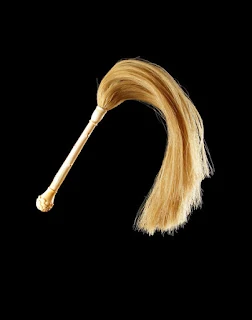
Omukhinga
- Ebieyo- brooms. Used by females in marriage songs of esidialo. Also, in songs sang during excommunication of a wrong doer, women performed mock sweeap dance on path used by the person.

Ebieyo - Esikong'o- clubs. Common hand props in war songs, mock fight songs, circumcision songs and twin dance. Used by males and held in left hand. During some cultural functions, it is called ekhendie.
- Ebimwero- weaven unsmeared basket skillfully balanced on the head or held in armpit. They are used in wedding songs, work song and marriage songs. Mothers visiting new borns brought presents in baskets. Used by females.
- Efumo- the spears. These were for mock fight, some marriage dances and war dances. Spears for these dances were made without the metal part.
- Emikho- new white cooking sticks. They are used by the aunts during circumcision songs, used by women in song of lamentations and also in marriage songs. They were held in hands by the females.
- Enjabasi- ivory wrist band used by lowest ranking elocutionist in a dance.
- Epokoto- ivory arm band put on upper arm as symbol of highest ranking elocutionist in a dancr.
- Esimbo ekhendie- Walking sticks- used in marriage songs, funeral songs and circumcision songs. Held in hand by males.
- Enderu- woven trays. They are used in marriage songs and work songs. Used by females in the dances. Those fir dance are not smeared.
- Engawo- shields. They were used when singing war dance, mock fight and wrestling dances. Used by males.
- Engeso- small sicles. They were used as props during harvesting song and marriage songs. Used by females.
- Essanda (esisanda)- Calabash used as props by men in marriage songs and work songs. Small calabashes were used by women in marriage dances while big ones were used by the males.

Amasanda - Oluyini- small jembe handles commonly used in marriage songs by the men.
- Oukhola- Chest and shoulder cover. This was used to cover the chest and stomach during a dance. Some had fur projection around the shoulders that enhanced the shaking of shoulders during kamabeka dance. It is mentined im the white ant harvesting song: Nakhaswa khano... omukhasi wa Lukhoba keboha olukhola mwikosi." That it was only Chief Lukhoba's wife, shethe with chest and shoulder cover, who was exempted from working. The song encouraged hard work. The normal clothing attire to cover chest and shoulders was called echabe.
- Amatware- beads made from grey and white seeds from reeds. Put on hand, legs down the shoulders to cross at chest ans back.
- Endunga- beads put in the beck.
- Engokhe- these were white soil body decorations that were circular or v-shapped. The colour was usually white, black or grey.
- Esaambo- decorations made on girl who is getting married. They enhanced tatoos. They had specific names as under:
- Ebibaka- decorations or tatoos on back, chest or lower stomach area
- Amatete- decorations or tatoos on cheeks.
- Amaliba- decorations or tatoos on hands.
- Embeetero- tatoos or decorations on the forehead.
- Omutoba- this was red lips colour for the female dancers. It came from the root of a tree called omutoba or omutaa.
- Omutuma- these were red soil body decorations on face, chest and legs. The decorations were always circular or oval.


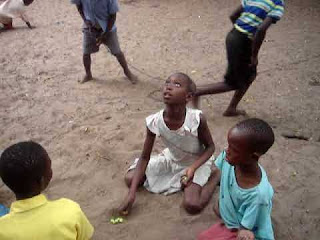
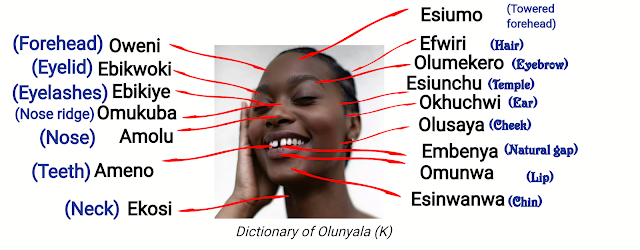

Comments
Post a Comment